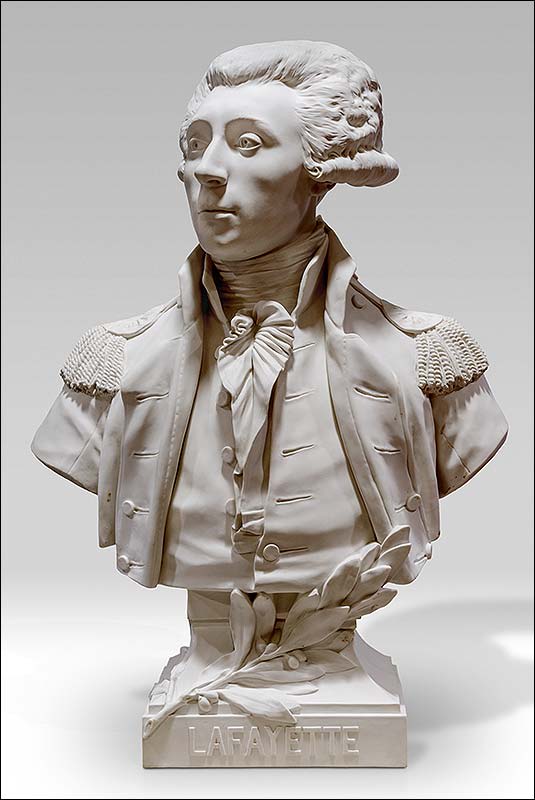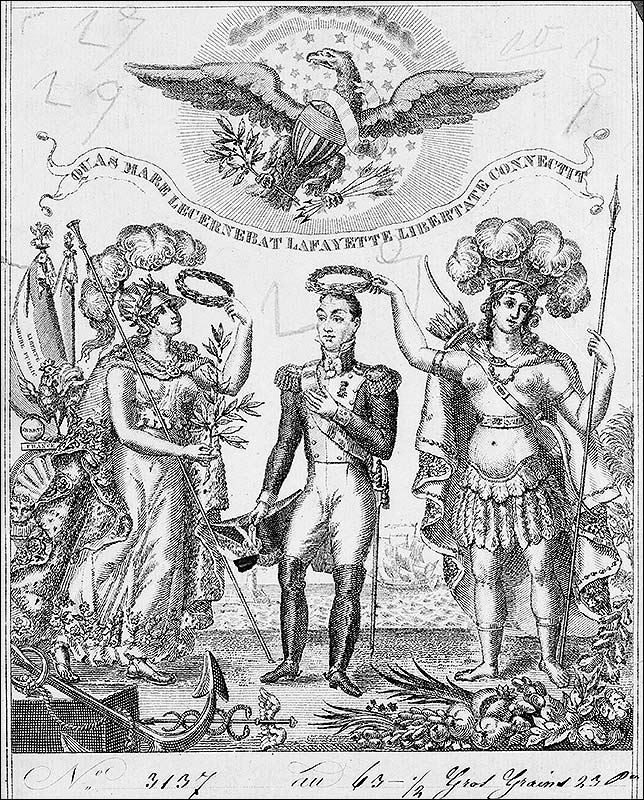At a dinner party in 1775, a young Gilbert du Motier — the Marquis de Lafayette — met the younger brother of King George III, the Duke of Gloucester, and before long, talk around the table turned to events abroad. Lafayette’s companion described a growing rebellion in British North America. Groups of unruly Colonists across the Atlantic dared to stand against their imperial father in the name of liberty and justice. The exchange lit a spark within Lafayette that soon turned to the fire of action. He later recalled that in that moment, “My heart was enlisted.”
The next year, a small American delegation including Silas Deane and Benjamin Franklin arrived in France to begin recruiting support and supplies for the war effort. In the ensuing series of conversations and negotiations, Lafayette impressed the Americans with his passion. Deane glowed about Lafayette’s “zeal for the liberty of our provinces” and offered him a position as a major general in the Continental Army.
Getting to North America to claim that commission presented a challenge. Lafayette anticipated the blessings of his superiors to fight in the nascent American war and readied a ship, the Victoire. Instead of approving, King Louis XVI reprimanded him and ordered him to stay in France. Lafayette weighed the decision between obedience and action, and chose to go, despite attempts to block his way.
That single decision was a pivotal one for the American war effort. The French aristocrat had joined the Royal Army at age 14 but was untested on the battlefield when he came to America. But Lafayette proved to have a military mind capable of anticipating tactical opportunities and carrying out plans that were magnificently simple — and undeniably successful.
“In America, he proved himself an able and energetic battlefield commander,” retired Gen. Wesley K. Clark wrote in the foreword of Lafayette: Lessons in Leadership from the Idealist General. “He was an ingenious and clever planner, courageous under fire. He adroitly sidestepped early mistakes and came to display incredible judgment and maturity in battlefield command.”
Lafayette was just 19 when he left France, his pregnant wife and a young daughter in 1777 to support American independence. Deane might have offered Lafayette a general’s rank, but he still needed to lobby the Continental Congress to give him the commission.

And the Americans were skeptical. Here was a foreign actor with an unsolicited offer to fight in a war that was not his own. He brought men, money and supplies but no military experience.
While he was untested in battle, he carried a passion for America’s future. On his arrival in the Colonies, Lafayette wrote to his wife, “Manners in this world are simple, honest and, in all things, worthy of the country where the beautiful word liberty resonates.” His commitment to that beautiful word — and his connections to the court of Louis XVI — eventually won over the American leadership. It helped, too, that Lafayette offered to serve at his own expense without pay.
He was attached to a division of Washington’s army in September 1777 when his unit met British Gen. William Howe’s forces at Brandywine near Philadelphia. Though the battle ended in the Americans’ retreat, Lafayette scored something of a personal victory when he took a musket ball to the leg. If he sought fame and notoriety, he found it through that wound. The injury was not life-threatening, but it forced him off the field and into the hospital. For several weeks he spent his time in vigorous study and correspondence. Through his letters to American and French allies, he fixed in their minds that he was capable and committed. He returned to the army in October and by December had received the blessings of Congress and the command of a division.
Lafayette’s assignment, at this moment, was at Valley Forge, where he began to see some of the challenges that he would face throughout the war. Supplies promised to the troops were stuck in another state. Military and civilian leaders jockeyed for power, with some attempting to relieve Washington of his command. Lafayette saw that the war for independence was both military and political and would demand thoughtful strategy to win on both fronts.

Winter’s thaw put troops on the move again in the spring of 1778. It also brought some much-needed good news to the campaign. In May, the Americans forged a formal alliance with France.
The Treaty of Amity and Commerce signaled both the promise of French troops and supplies and the hope that the young United States might enjoy a place among the nations of the world. As good as this news was for the future, at that moment Washington and Lafayette saw the British army preparing to move from Philadelphia.
Washington sent Lafayette on a mission to determine Howe’s next move and, if possible, to make a strategic strike against the British. After pulling together a force of regulars, militia and Oneida Indian warriors, Lafayette pressed toward Philadelphia and set up camp at Barren Hill. Washington had advised him to keep on the move, but he camped too long in sight of the enemy and drew an attack from Howe’s men. Lafayette and his troops skillfully managed to slip out of a multisided ambush and retreat to safety with only minimal casualties.
This experience must have fixed in his mind some valuable lessons: A leader can succeed through decisive victory, but he might also succeed by engaging strategically, keeping the enemy off balance and retreating to fight again.
Lafayette continued to win the respect of his peers and his commander as an American officer. His actions earned plaudits from the Continental Congress, too. In a letter to Louis XVI, Congress said Lafayette was “wise … gallant … and patient under the hardships of war.”

But he longed to serve in the ranks of the French army, and late in 1778, Lafayette requested leave to return home. When he arrived in February 1779, French society greeted him as a hero. Still, he had to seek forgiveness for disobeying the king’s orders. A few days of symbolic house arrest settled that debt.
Lafayette then set his mind to imagining how the French and Americans might defeat the British. After months of deliberation and planning, he boarded the Hermione in March 1780 to return to America. Almost immediately, Lafayette put his skills as a commander and strategist to work, but the biggest tests for him came in 1781. In the very first days of that year, Benedict Arnold brought the war to Virginia, sacking Richmond and preparing the state for a larger British invasion. Both Washington and Gov. Thomas Jefferson wished to see Arnold answer for his treason, and Lafayette was sent to capture him. The mission was plagued by the same lack of provisions and reinforcements that the army had faced before. But now, the problems grew because the British navy managed to repel French supplies intended for soldiers weary of a war that was entering its sixth year.
Lafayette left Maryland and landed at Yorktown in mid-March, and within the span of six weeks had marched his men to Baltimore and back again to Virginia. These movements churned through both the soldiers’ supplies and their morale. In a string of letters to his military colleagues and government officials during that long campaign of 1781, Lafayette sought all sorts of materiel. “Many of the troops are entirely without shoes,” he wrote, adding to pleas for horses, wagons, guns and food.
The letters betray Virginia’s delicate position as the British invaders tried to seize the Commonwealth. The requests were not extreme — in fact, Lafayette’s frustration was that he needed to ask for such things at all. Virginia had not met its quotas in supplying men to fight. Nor did the state government seem prepared to outfit those who were arriving for its defense. Jefferson replied plainly that “it is not in my power to do anything.”
Scarcity compelled Lafayette to be creative. Writing to Washington in May 1781, he explained that in the present condition, he could not defeat British Gen. Charles Cornwallis, but neither could he risk doing nothing: One would end in certain defeat and the other would signal surrender. His strategy proved to be effective in the coming months. He told Washington that he was “determined to Skarmish, But not to Engage too far.”

Refusing to meet the British head-to-head, he chose instead to use his more nimble, smaller numbers to push and pull at the enemy lines. He had little choice, given the state of his troops. Lafayette spelled out the situation most clearly in the same letter to Washington: “Was I any ways equal to the Ennemy, I would be extremely Happy in my present Command — But I am not Strong Enough even to get Beaten.” These are powerful words from the leader who, in just a few months, would be essential to forcing the British — led by Cornwallis — to surrender at Yorktown.
The British pushed up the peninsula toward the capital, Richmond, hoping to destroy the city and capture the governor and Assembly. The government withdrew to Charlottesville for safety, yet some legislators fell into the hands of a British cavalry led by Banastre Tarleton. Jefferson narrowly escaped on horseback through the woods around Monticello as British dragoons arrived. Lafayette proceeded to strike small blows at the British units that raided central Virginia, drawing them into a kind of cat-and-mouse game. The enemy continued to hold the upper hand, but Lafayette succeeded in buying time to receive militia reinforcements from both Pennsylvania and Virginia. By the end of June, Lafayette’s numbers were equal to those of Cornwallis, who complained that he had “in vain endeavoured to bring the [Marquis] to action” and began to move back down the peninsula.
Still, the hardships continued. Real money was in short supply and Virginia currency depreciated almost daily. At different times, Lafayette noted some “poor fellows almost naked” among his ranks, and that “the want of arms and ammunition render our situation very precarious.” He summed up the situation in an August 1781 letter to Thomas Nelson, who had by then succeeded Jefferson as Virginia’s governor. Lafayette wrote that “it is useless to complain,” and that “whatever means are put into my hands I shall endeavor to use, and with pleasure.” By the end of the month, however, he confessed to Nelson that “should [the Army’s weakness] be known to Cornwallis he may ruin us at one stroke.”
Fortunately, the suffering and privations would see an end soon. Cornwallis occupied Yorktown with the hope that he would stay temporarily in advance of another move. The tides turned against him. Late summer brought more reinforcements to Virginia, including Washington and Rochambeau and significant portions of the allied armies. At the same time, the British navy lost control of the mouth of the Chesapeake, allowing French vessels to arrive with men and munitions. At the end of September, combined American and French forces marched toward Yorktown, where they would lay siege to Cornwallis and his troops. On the 19th of October, Cornwallis signed his surrender.
Lafayette could almost see into the future. Even before the siege at Yorktown, Lafayette wrote to Washington: “The enemy has been so kind as to retire before us. Twice I gave them a chance of fighting (taking care not to engage them farther than I pleased) but they continued their retrograde movement. Our numbers are I think exaggerated to them, and our seeming boldness confirms the opinion.” The young man, who twice left his home to fight in another nation’s war, helped bring the surrender of one of the most powerful and experienced commanders of his day.